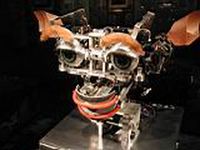
Before the holidays I paid a first visit to the MIT Museum. A rather interesting one-floor exhibit, up some modernistic steel stairs not far from the center of campus. I had heard that they had become the repository of a number of AI and robotics artifacts that I had read much about. So I wandered over there after some meetings and spent a few hours walking the exhibits.
You do understand quickly the quandry of the director of such a museum. Its easy to display artifacts that deal with robotics, which readily lend themselves to physical objects. Artificial Intelligence, being a work of symbols and process, is harder to do, what you can do is display pictures of visionaries and descriptions of their work. Interactive displays are also used, but somehow they didn't work quite as well. A good, but not comprehensive set of robotics artifacts is displayed, its understandably about work at MIT. The picture above is one I took of their Kismet social robot.
The Museum also takes its displays from before the immediately modern. I much enjoyed the large display of the work of Harold Edgerton, famously responsible for the use of the electronic stroboscope to provide slices of time we have not seen before. Also, a display that contained some sample exams from long ago that showed we have not necessarly progressed in understanding basic knowledge.
Another room covered the technical experiences of the MIT student ... which I imagine would be most interesting to alumni, but I also found element of it to be amusing.
Parts of the collection, such as the kinetic sculpture exhibit and the collection of ship images, while of technical and artistic interest, appear to be a bit out of place and likely mostly opportunistic.
Well worth a visit, for more detail, see the link above, which does a nice job of providing an overview of each exhibit, and an e-gallery which extends the exhibits. As I walked about I did muse about the future of museums. There were many times I would have liked to be able to click-through for more information. There were other times, where I was able to walk around each piece, encounter physically, even touch items in ways I could not online. Exhibits that were symbolic, without artifacts, probably could have been encountered better online. There is still a place for located artifacts and even places to encounter history directly. But for how long?
No comments:
Post a Comment